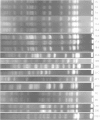Spread of carbapenemase-producing enterobacteria in a southwest hospital in China
- PMID: 25113057
- PMCID: PMC4236511
- DOI: 10.1186/s12941-014-0042-4
Spread of carbapenemase-producing enterobacteria in a southwest hospital in China
Abstract
Background: The rapid emergence and dissemination of carbapenem resistance in Enterobacteriaceae complicates the treatment of infections caused by these organisms.
Methods: We collected clinical isolates with meropenem inhibition zones of ≤ 22 mm from January 1, 2009, through December 31, 2010. We attempted to amplify the NDM-1 gene from these isolates and conducted the modified Hodge test (MHT). The minimal inhibitory concentration (MIC) of the MHT-positive strains was determined by the agar disk dilution method. The carbapenemase-encoding resistance genes of these strains were examined using polymerase chain reaction (PCR) analysis and a sequencing strategy to characterize these enzymes. The clonal relationship among isolates was analyzed by pulsed-field gel electrophoresis (PFGE).
Results: Among the 158 Enterobacteriaceae isolates that were collected, there were no NDM-1-positive strains and 26 MHT-positive strains. Among the latter, 18 strains were IMP-4-positive, and 1 was KPC-2-positive. In addition, 15 of the IMP-4-positive Klebsiella pneumoniae strains belonged to 4 PFGE genotypes, with 8 strains having the same genotype.
Conclusion: These results suggest that nosocomial infections are one of the main reasons for the spread of these resistant strains.
Figures
Similar articles
-
Molecular study of carbapenemase genes in clinical isolates of Enterobacteriaceae resistant to carbapenems and determining their clonal relationship using pulsed-field gel electrophoresis.J Med Microbiol. 2017 May;66(5):570-576. doi: 10.1099/jmm.0.000467. Epub 2017 May 9. J Med Microbiol. 2017. PMID: 28485708
-
Prevalence and Molecular Characteristics of Carbapenemase-Producing Enterobacteriaceae From Five Hospitals in Korea.Ann Lab Med. 2016 Nov;36(6):529-35. doi: 10.3343/alm.2016.36.6.529. Ann Lab Med. 2016. PMID: 27578505 Free PMC article.
-
Emergence of NDM-1- and IMP-14a-producing Enterobacteriaceae in Thailand.J Antimicrob Chemother. 2012 Nov;67(11):2626-30. doi: 10.1093/jac/dks267. Epub 2012 Jul 13. J Antimicrob Chemother. 2012. PMID: 22796889
-
Prevalence and molecular epidemiology of acquired AmpC β-lactamases and carbapenemases in Enterobacteriaceae isolates from 35 hospitals in Spain.Eur J Clin Microbiol Infect Dis. 2013 Feb;32(2):253-9. doi: 10.1007/s10096-012-1737-0. Epub 2012 Sep 7. Eur J Clin Microbiol Infect Dis. 2013. PMID: 22956023
-
Detection of the novel IMP-38 among carbapenemase-producing Enterobacteriaceae in a university hospital, China.J Infect Dev Ctries. 2014 Aug 13;8(8):1044-8. doi: 10.3855/jidc.4179. J Infect Dev Ctries. 2014. PMID: 25116672
Cited by
-
Prevalence and clonal diversity of carbapenem-resistant Klebsiella pneumoniae causing neonatal infections: A systematic review of 128 articles across 30 countries.PLoS Med. 2023 Jun 20;20(6):e1004233. doi: 10.1371/journal.pmed.1004233. eCollection 2023 Jun. PLoS Med. 2023. PMID: 37339120 Free PMC article.
-
Molecular characterization of clinical IMP-producing Klebsiella pneumoniae isolates from a Chinese Tertiary Hospital.Ann Clin Microbiol Antimicrob. 2017 Jun 19;16(1):42. doi: 10.1186/s12941-017-0218-9. Ann Clin Microbiol Antimicrob. 2017. PMID: 28629366 Free PMC article.
-
Performance evaluation of three automated identification systems in detecting carbapenem-resistant Enterobacteriaceae.Ann Clin Microbiol Antimicrob. 2016 Jun 21;15(1):40. doi: 10.1186/s12941-016-0154-0. Ann Clin Microbiol Antimicrob. 2016. PMID: 27328762 Free PMC article.
-
Tandem Repeat of bla NDM-1 and Clonal Dissemination of a fosA3 and bla KPC-2 Co-Carrying IncR-F33: A-: B- Plasmid in Klebsiella pneumoniae Isolates Collected in a Southwest Hospital in China, 2010-2013.Infect Drug Resist. 2022 Dec 15;15:7431-7447. doi: 10.2147/IDR.S391144. eCollection 2022. Infect Drug Resist. 2022. PMID: 36544990 Free PMC article.
-
Carbapenemase-producing bacteria in food-producing animals, wildlife and environment: A challenge for human health.Ital J Food Saf. 2019 Jun 20;8(2):7956. doi: 10.4081/ijfs.2019.7956. eCollection 2019 May 23. Ital J Food Saf. 2019. PMID: 31316921 Free PMC article.
References
-
- Thurlow CJ, Prabaker K, Lin MY, Lolans K, Weinstein RA, Hayden MK. Anatomic sites of patient colonization and environmental contamination with klebsiella pneumoniae carbapenemase-producing Enterobacteriaceae at long-term acute care hospitals. Infect Control Hosp Epidemiol. 2013;34:56–61. doi: 10.1086/668783. - DOI - PMC - PubMed
MeSH terms
Substances
LinkOut - more resources
Full Text Sources
Other Literature Sources


